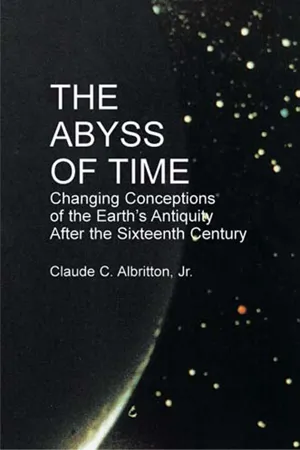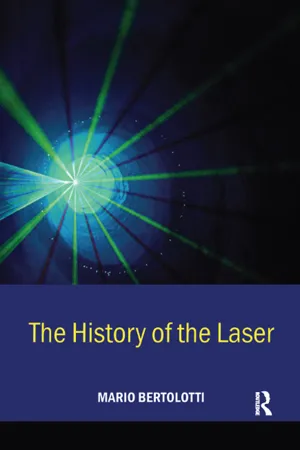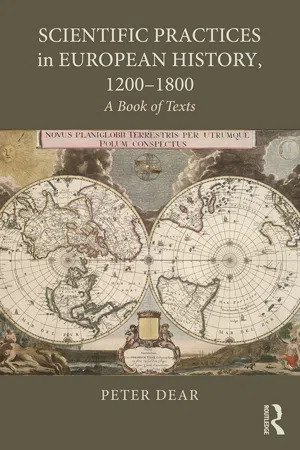Physics
Robert Hooke
Robert Hooke was an English scientist who made significant contributions to the field of physics. He is best known for his work in microscopy and his discovery of cells, which he observed in a thin slice of cork under a microscope. Hooke's observations and writings laid the foundation for the study of cells and the development of the cell theory.
Written by Perlego with AI-assistance
Related key terms
Related key terms
1 of 4
Related key terms
1 of 3
3 Key excerpts on "Robert Hooke"
- eBook - ePub
The Abyss of Time
Unraveling the Mystery of the Earth's Age
- Claude C., Jr. Albritton(Authors)
- 2012(Publication Date)
- Dover Publications(Publisher)
The Mr. Hook of this footnote is of course Robert Hooke, who continues to be acknowledged in footnotes wherever such diverse topics as optics, astronomy, microscopy, atomic theory, horology, thermodynamics, paleontology, botany, oceanography, geology, or navigation are detailed in an historical context. Perhaps he is most widely known for his discovery of the law of elasticity—Hooke’s Law, the proposition that deformation of elastic bodies is proportional to the force applied. Less well known are his formulations of atomic and kinetic theory. Hooke held that the properties of matter are to be understood in terms of the motions and collisions of atoms, and that what we call heat is no more than the property of a body arising from the motion or agitation of its parts. His experiments in optics contributed to the wave theory of light and further elucidated the phenomenon of diffraction.Hooke was not, however, concerned wholly or even mainly with theory. He was a practical man, an inventor, a “mechanick genius” in the estimation of his contemporaries. He has been credited with the invention of the universal joint, the wind gauge, the wheel barometer, a water sampler for collecting sea water at measured depths, the anchor escapement of pendulum clocks, and the balance spring for watches. Working with Robert Boyle, he built a device for evacuating air from a glass chamber, and the experiments conducted with the aid of this “pneumatic engine” demonstrated that air is necessary for combustion, for the respiration of animals, and for the transmission of sound. Through microscopes, improved according to his own design, Hooke examined a variety of artifacts and natural objects, discovering among other matters that the most pointed needle does not actually end in a point and that mites, lice, and fleas possess a peculiar beauty of their own. Examining thin slices of cork he discovered the cellular structure of plants, and named the tiny compartments “cells” because they reminded him of the clusters of small rooms occupied by monks.These accomplishments, and the fame that came with them, could hardly have been predicted from consideration of his childhood and early upbringing (2). Hooke was born on July 18, 1635, at the town of Freshwater on the Isle of Wight, where his father was curate of the Church of All Saints. The Reverend John Hooke, hoping that his son would also become a clergyman, served as tutor in subjects he considered appropriate to the ministry. But the son was more interested in drawing, and in making mechanical toys; by the time he was thirteen he had built from wooden parts a clock that would run, and had constructed a model ship that would fire off small guns as it sailed near shore. In 1648 the father died, and young Hooke was sent off to London with an inheritance of £100 to study art as apprentice to Peter Lely, the portraitist. But the smell of paint made the boy’s head ache, and so he left with his hundred pounds and enrolled at Westminster School, where he came under the influence of the Headmaster, Dr. Richard Busby, who was famous for his skill as a teacher. Recognizing Hooke’s unusual mental endowments, Busby coached him in studies of geometry, in other branches of mathematics, and finally in mechanics, the subject for which Hooke ever afterward showed an especial fondness. Not all of his training at Westminster was mathematical and scientific; following the classical tradition of learning, he studied Latin and Greek and acquired some competence in Hebrew. Also he studied music and learned to play the organ. Though Hooke possessed a natural vigor, his health was always delicate, and when he was about sixteen years old a growing deformity manifested itself in a crooked posture which marked him for life. - eBook - ePub
- Mario Bertolotti(Author)
- 2004(Publication Date)
- CRC Press(Publisher)
He was an accomplished surveyor and architect who helped to rebuild London after the Great Fire of 1666. He was one of the first to articulate the concept of extinction and who suggested evolution two centuries before Charles Darwin. He started his scientific career as an assistant of the well-known English chemist Robert Boyle (1627–1691) who, after studying at Eton and Geneva, in Oxford in 1654 began work on the properties of gases and vacuums. In 1658–59, Hooke built a vacuum pump for Boyle of the kind invented in 1650 by Otto von Guericke (1602–1686), and helped in the demonstrations Boyle gave in those years during which he showed that air is essential for the transmission of sound, breathing and combustion. In the same period, Boyle expressed the famous law—which in the UK bears his name and in continental Europe is often attributed to Mariotte—according to which the product of the pressure of a gas and its volume is a constant if, just as pointed out by Mariotte, temperature remains constant. Boyle was so satisfied with Hooke that in 1662 he appointed him first Curator of Experiments at the Royal Society for the Improvement of Natural Knowledge, the English Academy of Sciences, founded by him in 1660 together with other English scientists under the auspices of Charles II. The role of the society was ‘to improve the knowledge of natural things’ by observation and experiment rather than by appealing to literary authorities: the society’s motto is Nullius in Verba (‘on the words of no one’). To this end the society appointed a curator of experiments. In this role, Hooke, whenever the Society held its meetings, was required to perform three or four experiments, and even if the Society hosted a meeting only once per week, the task was rather onerous and binding - eBook - ePub
Scientific Practices in European History, 1200-1800
A Book of Texts
- Peter Dear(Author)
- 2017(Publication Date)
- Routledge(Publisher)
11 SEEING NEW THINGSJust as the telescope revealed hitherto unsuspected novelties on the grand scale of the heavens, so a similar optical instrument, the microscope, proved capable of revealing novelties at the level of the very small. Although the principle of the microscope had already been discussed by Galileo in 1623 in his The Assayer , it was in 1665 that the first real classic in microscopical observation appeared. Robert Hooke’s Micrographia garnered much attention for its lavish illustrations (some perhaps done by Christopher Wren), but Hooke’s work also promoted the idea that empirical research in the natural sciences could be improved by devising instruments to assist the senses in general, not only that of vision. In these views Hooke echoed Francis Bacon, who also anticipated means of improving the senses. Indeed, Hooke, who was employed by the Royal Society as its “curator of experiments,” responsible for trying experiments when ordered, and for entertaining the Society’s meetings with experimental demonstrations of his own, frequently invoked Bacon’s name as a guide to the right way to go about doing experimental natural philosophy.Source: Robert Hooke, Micrographia (London, 1665). The preface with omission of some detailed descriptions of instruments.The prefaceIt is the great prerogative of Mankind above other Creatures, that we are not only able to behold the works of Nature, or barely to sustein our lives by them, but we have also the power of considering , comparing , altering , assisting , and improving them to various uses. And as this is the peculiar priviledge of humane Nature in general, so is it capable of being so far advanced by the helps of Art, and Experience, as to make some Men excel others in their Observations, and Deductions, almost as much as they do Beasts. By the addition of such artificial Instruments and methods , there may be, in some manner, a reparation made for the mischiefs, and imperfection, mankind has drawn upon it self, by negligence, and intemperance, and a wilful and superstitious deserting the Prescripts and Rules of Nature, whereby every man, both from a deriv’d corruption, innate and born with him,1
Index pages curate the most relevant extracts from our library of academic textbooks. They’ve been created using an in-house natural language model (NLM), each adding context and meaning to key research topics.
Explore more topic indexes
Explore more topic indexes
1 of 6
Explore more topic indexes
1 of 4


